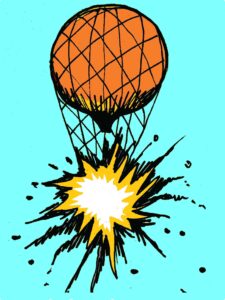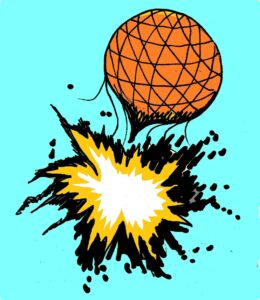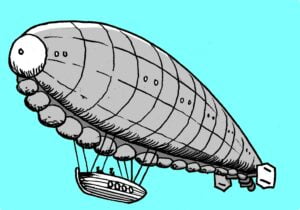As long ago as the 3rd century BC. Yes. That long ago!
Chinese Lanterns
 Yes, those traditional Chinese lanterns, which we still see today, are believed to have been used in Ancient China as military communication stations.
Yes, those traditional Chinese lanterns, which we still see today, are believed to have been used in Ancient China as military communication stations.
There is no proof, but it has been suggested that they may even have put a man underneath. I’m not certain how a paper balloon could support the weight of a man, however small, on the other hand we do know that they were used as airborne lanterns for military signalling.
It was 1794 before it was tried again.
Naturally, it was Napoleon who thought they could be useful and he founded the “Compagnie d’aérostiers”( French Aerostatic Corps).
His idea was to use balloons for reconnaissance. He tried this at the Battle of Fleurus in 1794, it didn’t really work for him, so a year later at the Siege of Mainz, he used them again. He wasn’t impressed, he found they couldn’t fly in bad weather, fog, high winds, and the clincher, was they were large easy targets, so in 1799 he disbanded them.
The Siege of Venice in 1849
 During this siege, the Austrians attempted to float 200 paper hot air balloons over Venice.
During this siege, the Austrians attempted to float 200 paper hot air balloons over Venice.
Each one had an 11–14 kg bomb with a time fuse strapped underneath, and as it got over the city the plan was that it would drop from the balloon.
t failed!
Unfortunately, for the Austrians the wind changed. You guessed it. Yes, they drifted back over the Austrians! There was chaos, as they tried to avoid being killed by their own bombs!
Napoleon III did use them.
He found them useful in his victory over the Austrians in 1859.
Then he used them again in 1870 when the Prussians surrounded Paris, cutting it off from the rest of the world. The Parisians used the cities railway stations, commandeered all the silk they could find, and they made 66 balloons, which carried over 100 people and 11 tons of mail out of the city, floating over the Prussians heads to freedom.
It was probably the only successes the French could claim from that siege.
The American Civil War
 In this war balloons were, finally, successfully used as observation towers by the Union Army. However, they had learnt from the Austrian’s experience, so this time they attached the balloons to 1000 feet of rope, making certain that they didn’t drift over the Confederate Army and get shot down. They were convinced that if this happened, they would be shot as spies.
In this war balloons were, finally, successfully used as observation towers by the Union Army. However, they had learnt from the Austrian’s experience, so this time they attached the balloons to 1000 feet of rope, making certain that they didn’t drift over the Confederate Army and get shot down. They were convinced that if this happened, they would be shot as spies.
Along came the Wright Brothers.
 Once the Wright Brothers, on December 17, 1903, had proved that their plane could actually fly, it didn’t take long for the military to see they had a new weapon of war.
Once the Wright Brothers, on December 17, 1903, had proved that their plane could actually fly, it didn’t take long for the military to see they had a new weapon of war.
By the time of the 1911 Italo-Turkish War the Italian Army used monoplanes to bomb a Turkish camp at Ain Zara in Libya. This is the first recorded use of planes in war. Then, in the First Balkan War the following year, the Bulgarians used air power to bomb Turkish positions at Adrianople. After that, with the advent of World War 1, they really started using planes as a weapon of war.
It took from the 2/3rd Century BC until 1914 for the air war to become one where men in flying machines could dice in the air.
Isn’t history fun?
10 questions to discuss:
- Early Chinese Uses: While military communication is mentioned, were there other possible applications of balloons in ancient China, beyond signaling?
- Napoleon’s Experimentation: What were the specific challenges Napoleon encountered with using balloons for reconnaissance, besides bad weather and vulnerability?
- Austrian Balloon Failure: Beyond wind direction, were there other factors contributing to the disastrous outcome of the Venetian bombing attempt?
- Parisians’ Success: How did the Prussians react to the Parisians’ escape using balloons, and did this event have any impact on the siege’s outcome?
- Civil War Innovations: Can you elaborate on the specific observation techniques and strategies used by the Union Army with their tethered balloons?
- Transition to Airplanes: How did the development of airplanes differ from balloons in terms of military applications and impact on warfare?
- Early Aerial Bombing: Beyond the first recorded instances mentioned, were there any significant bombing campaigns or technological advancements during the Italo-Turkish and Balkan Wars?
- Beyond Bombing: In World War I, what other roles did airplanes play besides bombing, and how did these roles evolve throughout the conflict?
- Long-Term Impact: How did the early use of balloons and airplanes in warfare pave the way for the development of modern air forces and aerial combat strategies?
- Ethical Considerations: The blog mentions concerns about captured balloonists being considered spies. How did the treatment of aircrews evolve throughout these early conflicts, and what are the ethical issues surrounding aerial warfare today?
These questions go beyond summarizing the blog and encourage critical thinking about the historical development, challenges, and ethical considerations of using balloons and airplanes in warfare.
For more on this click on:
https://en.wikipedia.org/wiki/History_of_aerial_warfare
https://www.battlefields.org/learn/articles/civil-war-ballooning
© Tony Dalton

